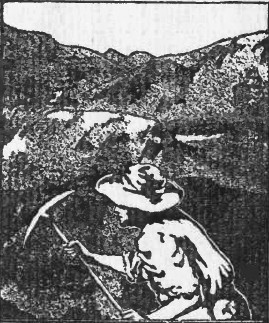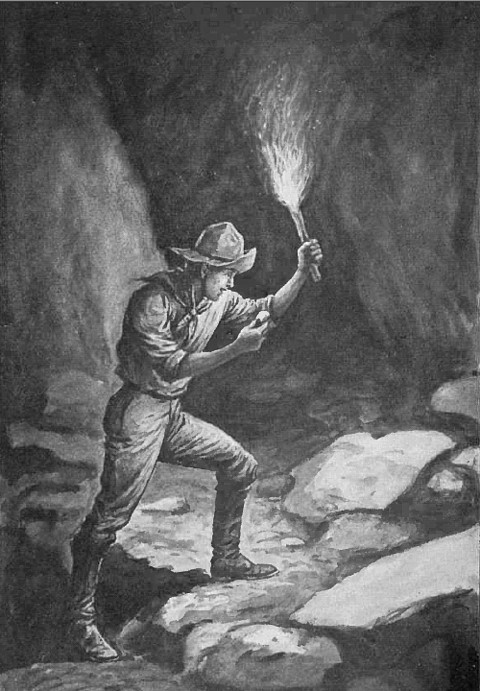Silver:
Silver is generally found in serpentine, trap, sandstone, limestone,
shale, or porphyry rocks, the gangue being quartz, calc,
fluorite, or barite. All
silver ores are heavy, and many of them are sectile, i.e.,
may be cut with the knife. Western men test for silver by heating the ore
and dipping it into water. Some metal comes to the surface in a greasy scum,
should silver be present. Native silver is found occasionally. Owing to the
fall in value of this metal its future is not assured. It has fallen, during
the past year, once to forty-nine cents an ounce, and this has had a most
disastrous effect upon many silver mines, forcing them to suspend
operations. Should the fall continue, as seems likely, and the price of
silver go down to forty cents an ounce, little will be produced except as a
by-product in the treatment of argentiferous lead ores.
As silver enters into chemical combination with sulfur easily, as is seen by the black film that forms on silver articles in a room where gas is burnt, most silver ores are sulfides. The very abundance of silver has caused its great fall in value, and it does not appear that it is ever likely to remain for long at a price exceeding fifty cents an ounce, owing to the ease with which it may be produced, and the large quantities that must find their way to market through it being a by-product in lead smelting. From 1859 to 1891 the Comstock lode in Nevada produced $325,000,000. This lode is a belt of quartz, 10,000 feet long and several hundred wide, and is a contact vein between diorite and diabase. In America galena is the principal source of silver; the chlorides and oxides rank next; while, lastly, some silver is parted from gold when it reaches the mint, as gold always contains more or less of that metal. No precise statement as to the manner of its occurrence may be made since it is found in many different positions, and is associated with all sorts of minerals. It is never found in placer deposits, as it breaks up under the influence of water, air, etc. Its original source is doubtless the igneous rocks, where it occurs in association with augite, hornblende and mica.
Silver may be expected in
mountainous regions of recent origin. Between 1875 and 1891 the world's
product rose from $82,000,000 to $185,599,600. Three quarters of this came
from the western hemisphere. The commercial ores of silver are:
Argentite Ag2S 87.1 per cent
Proustite 3Ag2SAs2S3 65.5 per cent
Pyrargyrite 3Ag2SSb2S3 59.9 per cent
Stephanite 5Ag2SSb2S3 68.5 per cent
Cerargerite AgCl 75.3 per cent
The Anaconda mine in Butte was one the largest producer of silver in the
country. In 1896 its output was 5,000,000 ounces. The Anaconda was also the
heaviest copper producer in the United States, its yield of copper being
125,350,693 pounds.
Copper:
Native copper occurs in the Lake Superior region, but the demands of
commerce are supplied from
chalcopyrite or copper pyrites, and
tetrahedrite or gray copper ore. Many different ores of
copper may exist in the same vein. On the surface an iron cap of gossan
reveals the deposit; immediately below may be black oxide of copper with
some
malachite, lower down red oxide, and below the water-line
copper sulfides. The following are the principal copper ores:
Sp. Gravity. Hardness. Percentage Cu.
Native copper 8.8 2.8
100
Chalcopyrite 4.2 3.7
35
Enargite 4.4 3.0
48
Tetrahedite 5.0
3.51 35
Chalcocite 5.6 2.7
80
Bornite 5.0 3.0
55
Melaconite 6.2 2.0 to 3.0
80
Cuprite 6.0 3.6
89
Chrysocolla 2.2
3.0 45
The common ore is native copper, often associated with native silver, the two remaining, chemically, quite distinct. Some masses of copper occur that are too large to handle and must be cut by cold chisels, a method that costs more for labor than the value of the metal. The Lake Superior mines produce 140,000,000 pounds of copper a year, while those of Montana made the gigantic output of 228,000,000 pounds in 1896. Arizona has also produced very large amounts of copper ore. A century ago, the great Anaconda mine, of Butte, was the heaviest producer, yielding more than half the state's total. During 1899 the New York copper market rate varied between 14.75 cents and 18.46 cents per pound. Copper is probably abundant in the shape of pyrites in many parts of Canada, especially in the Northwest, and prospectors in that region should search diligently for it. The Lake Superior mines are unique in being deposits of native copper. Owing to the great demand for copper following upon the extraordinary spread of electricity, copper properties have become so enormously valuable that, possibly, the explorer will be quite as fortunate in finding copper as in finding gold.
Moreover, with the exception of Spain and Chili, the United States has no serious rivals in copper production, Montana and Michigan, producing the greater part of the output.The famous Calumet and Hecla mine, in Michigan, is now down 4,000 feet and still yields copper ore. The most copper ores are not difficult to distinguish. Every one is familiar with the ruddy hue of pure copper, the color of the native metal. It may be flattened under the hammer or cut with the knife. A little of the ore mixed with grease colors a flame green. Copper ores are heavy, and generally of a bright color, either red, blue, green, yellow or brown.
Lead:
The two important sources of supply are
galena and cerussite. The former contains 87 percent of lead,
and frequently some silver and gold. It is so distinctive as to be easily
recognized. Luster, metallic; opaque; lead-gray; harsh. Brittle to sectile
(may be cut). Cleavage, perfect. Fracture, even to sub-conchoidal.
Structure, granular or foliated, tabular, or fibrous. Specific gravity is
7.5, and hardness, 2.6. The carbonate
cerussite contains about 79 per cent lead. Luster, vitreous to
resinous. Translucent. Color, gray. Smooth. Brittle. Cleavage, perfect to
imperfect. Fracture, conchoidal. Massive to granular. Rich carbonate ores
look like clay, and are undoubtedly often passed by. The economic ores of
lead are:
Galena PbS 86.6 percent lead
Cerusite PbCO8 77.5 percent lead
Anglesite PbSO4 67.7 percent lead
Pyromorphite Pb3P2O8 plus 1-3 PbCl2 75.36 percent lead.
Lead ores are frequently rich in silver. They occur in limestone, sandstone, granite and clay. The commercial ores are galena, which is easily recognized by its steel-like cubes, and the carbonates. These latter are like lightly colored clays when in powder and are very apt to be overlooked. Fluor spar is as favorable a gangue for lead as quartz is for gold.
The Rocky Mountains were the principal American sources of this metal, but a very large amount came from the Mississippi valley. In the mountains the ore is a by-product, in silver smelting, being obtained from argentiferous galena, while in Missouri, Kansas, Wisconsin and Illinois lead and zinc are found free from any mixture with the precious metal. The age of these deposits varies from lower Silurian or Cambrian to the carboniferous. The ore is found in limestone rocks, sometimes in flat openings parallel to the almost horizontal beds, or else in gash veins almost at right angles to these. As lead is often found in dolomite limestone, that is, limestone carrying almost as much magnesia as lime, and this rock was undoubtedly deposited in a shallow sea, geologists incline to the belief that therefore the lead is due to a growth of seaweeds in whose ash this metal and zinc are known to occur. At any rate, these deposits now have great economic value, and the lead and zinc ore is easily got at. Galena and sphalerite frequently resemble one another, but they may be distinguished by this infallible sign: the powder of galena is black, and that of sphalerite brown, or yellow.
Continue on to:
Identifying Ores of Aluminum, Chromium and Iron
Return To:
Gold and Silver Prospecting Basics


